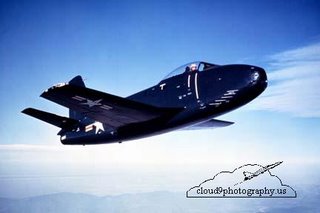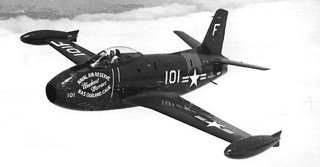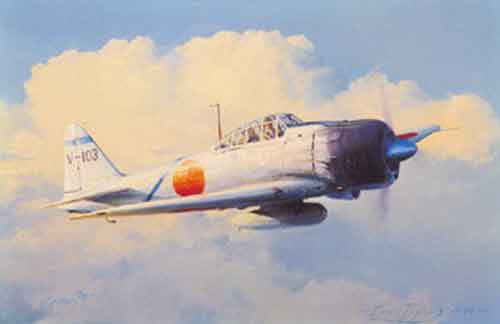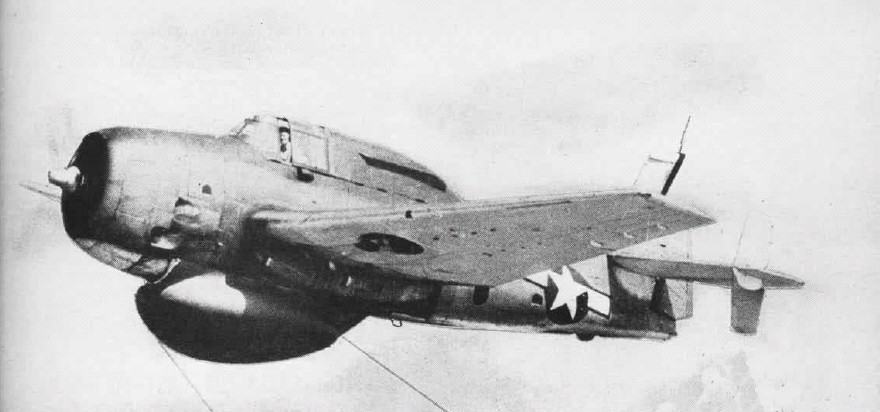Flightdeck Friday!
Ed note: Yes, it is early, but there are several other items on tap for the next few days, primary of which are a Reflections-series from Sept 11, 2001 beginning Friday and the planned memorial observance for this coming Monday. So, presented herewith is Flightdeck Friday — a day (or two) early…
North American XFJ-1/FJ-1 Fury
In 1944, mindful of the upcoming invasion of Japan (Operation Olympic/Coronet) and the USAAF’s development of jet fighters with the P-59 and P-80, the Navy asked three manufacturers – Vought, McDonnell and North American, to provide designs for consideration of a carrier-based jet fighter-bomber to be deployed by early 1946. With two of the three being non-traditional suppliers of Navy aircraft it was hoped that they would bring new ideas to the table while having little impact on the large production lines of Douglas and Grumman. The response was varied, ranging from the previously discussed Vought F6U Pirate with its hybrid
USAAF’s development of jet fighters with the P-59 and P-80, the Navy asked three manufacturers – Vought, McDonnell and North American, to provide designs for consideration of a carrier-based jet fighter-bomber to be deployed by early 1946. With two of the three being non-traditional suppliers of Navy aircraft it was hoped that they would bring new ideas to the table while having little impact on the large production lines of Douglas and Grumman. The response was varied, ranging from the previously discussed Vought F6U Pirate with its hybrid  materials to McDonnell’s two twin engine designs – the XFD-1 Phantom and XF2D-1 Banshee. Slotted in-between was a more conventional, simple design from North American – the NA-134. Designed around the General Electric J35 axial-flow engine, NA chose a simple “straight-through†arrangement with the intake in the nose of the short, thick fuselage. NA also decided that to ensure clean airflow, the inlet would not be bifurcated and as a result, the cockpit was mounted above the intake. With fuel tanks kept internal to the fuselage the result was the characteristic stuffed sausage look, yet unlike its stable mate from Vought, the Fury with its clean external lines would readily make a top speed of 550 kts.
materials to McDonnell’s two twin engine designs – the XFD-1 Phantom and XF2D-1 Banshee. Slotted in-between was a more conventional, simple design from North American – the NA-134. Designed around the General Electric J35 axial-flow engine, NA chose a simple “straight-through†arrangement with the intake in the nose of the short, thick fuselage. NA also decided that to ensure clean airflow, the inlet would not be bifurcated and as a result, the cockpit was mounted above the intake. With fuel tanks kept internal to the fuselage the result was the characteristic stuffed sausage look, yet unlike its stable mate from Vought, the Fury with its clean external lines would readily make a top speed of 550 kts.
 New Year’s Day 1945 saw NA being awarded a contract for three XFJ-1’s with a subsequent 100 FJ-1 Fury’s ordered the following May. The AAF also placed an order for the NA-140, the Fury’s shore-based cousin and after modifying the design to include swept wings, ended up with one of the most famous early jet fighters, the F-86 Saberjet (also a Scribe favorite, even sans tailhook – and yes, he does have The Hunters in his DVD library). Concern within the Navy about transitioning from prop to jet aircraft in the carrier environment and the low speeds mandated kept the initial order for Fury’s configured with straight wings.
New Year’s Day 1945 saw NA being awarded a contract for three XFJ-1’s with a subsequent 100 FJ-1 Fury’s ordered the following May. The AAF also placed an order for the NA-140, the Fury’s shore-based cousin and after modifying the design to include swept wings, ended up with one of the most famous early jet fighters, the F-86 Saberjet (also a Scribe favorite, even sans tailhook – and yes, he does have The Hunters in his DVD library). Concern within the Navy about transitioning from prop to jet aircraft in the carrier environment and the low speeds mandated kept the initial order for Fury’s configured with straight wings.
 The XFJ-1’s first flight was on November 27, 1946. Powered by a 3,820 lb s.t. J35-2, the Fury was armed with six .50 cal guns – the last Navy use of this size weapon. Production variants saw modifications to the dive brakes (being moved to the fuselage) and use of the Allison-built J35-A-2 engine. For a (brief) time, the FJ-1 claimed the title of fastest jet flying, attaining a speed of Mach .87 in 1947. Although 100 were ordered, post-war cutbacks and promise from the McDonnell designs led to only 30 FJ-1’s being purchased.
The XFJ-1’s first flight was on November 27, 1946. Powered by a 3,820 lb s.t. J35-2, the Fury was armed with six .50 cal guns – the last Navy use of this size weapon. Production variants saw modifications to the dive brakes (being moved to the fuselage) and use of the Allison-built J35-A-2 engine. For a (brief) time, the FJ-1 claimed the title of fastest jet flying, attaining a speed of Mach .87 in 1947. Although 100 were ordered, post-war cutbacks and promise from the McDonnell designs led to only 30 FJ-1’s being purchased.
One fleet squadron, the Screaming Eagles of VF-5A (later VF-51), one of the oldest Pacific fleet fighter squadrons, was outfitted with the Fury. By all counts, the aircrews were happy with the aircraft and its handling. The first CV-landing was made on the USS Boxer (CV 21) on 16 March 1948. Following the practice of the time, the initial launch was a deck-run, but when it was determined to be more operationally feasible (and safer) to launch using catapults, that became the norm for all future jet ops. The squadron also went on to win the 1948 Bendix Trophy, beating their USAF counterparts who were flying the F-80 in a cross-country race.
fighter squadrons, was outfitted with the Fury. By all counts, the aircrews were happy with the aircraft and its handling. The first CV-landing was made on the USS Boxer (CV 21) on 16 March 1948. Following the practice of the time, the initial launch was a deck-run, but when it was determined to be more operationally feasible (and safer) to launch using catapults, that became the norm for all future jet ops. The squadron also went on to win the 1948 Bendix Trophy, beating their USAF counterparts who were flying the F-80 in a cross-country race.
 provided valuable service in acclimating crews to CV-ops in jets, under-scoring the need for catapults to launch jets. Later, as the performance of the Navy’s straight wing jet fighters was outmatched by the swept-wing land-based jets, the Navy purchased three F-86Es and outfitted them with Navy-specific gear and strengthened fuselages. Designated the FJ-2, the Navy sought to produce enough to put into the Korean conflict, but concerns about competing with resources for the F-86 production line and emerging issues with a weak tailhook and nose strut/wheel led to delays in production until after the armistice was signed. This and later versions of the Fury would go on to fly with Navy and Marine Corps squadrons and be the first to trap aboard the new super carrier, USS Forrestal (CVA-59). An outstanding example is found today in the National Museum of Naval Aviation located onboard NAS Pensacola, FL.
provided valuable service in acclimating crews to CV-ops in jets, under-scoring the need for catapults to launch jets. Later, as the performance of the Navy’s straight wing jet fighters was outmatched by the swept-wing land-based jets, the Navy purchased three F-86Es and outfitted them with Navy-specific gear and strengthened fuselages. Designated the FJ-2, the Navy sought to produce enough to put into the Korean conflict, but concerns about competing with resources for the F-86 production line and emerging issues with a weak tailhook and nose strut/wheel led to delays in production until after the armistice was signed. This and later versions of the Fury would go on to fly with Navy and Marine Corps squadrons and be the first to trap aboard the new super carrier, USS Forrestal (CVA-59). An outstanding example is found today in the National Museum of Naval Aviation located onboard NAS Pensacola, FL.Specification of the FJ-1 Fury:
Engine: One Allison J35-A-2, 4000 lb.st.
Weights: 8843 pounds empty, 15,115 pounds takeoff (clean).
Performance:
Maximum speed 547 mph at 9000 feet.
Initial climb rate 3300 feet per minute.
Service ceiling 32,000 feet.
Fuel capacity included an internal load of 465 gallons and a pair of 165-gallon drop tanks at the wingtips, giving the FJ-1 a maximum range of 1500 miles.
Resources:
- Swanborough, Gordon and Bowers, Peter M. United States Navy Aircraft since 1911. Naval Institute Press, 1990.
- http://home.att.net/~jbaugher1/p86_19.html “North American FJ-1 Fury”
- http://en.wikipedia.org/wiki/FJ_Fury “FJ Fury”
Next week: OK, enough of this single seat stuff — time to get the NAO’s in the picture! This aircraft flew with the Navy and Marines in Korea and was responsible for downing more enemy aircraft than any other Navy/Marine fighter — The Douglas F3D Skynight!




One Comment
Comments are closed.